
Case Study Mastery: Examples & Step-by-Step Templates
Master case study: Uncover key strategies to conduct & present findings that influence decisions charachters.
February 9, 2024
.avif)
What's Inside?
Understanding and sharing success stories in the business management world is crucial for grasping the growth journey of a business.
In this article, we will delve into the concept of a business management case study, exploring its definition, benefits, limitations, step-by-step process, types, and essential elements.
What is a Case Study?
A case study research is a detailed analysis of a particular subject, often a real-world situation or scenario, to draw insights and conclusions. It serves as a valuable tool for learning from successful strategies, identifying challenges, and making informed decisions.

Key Characteristics of a Case Study:
Specific Focus: Case studies concentrate on a particular subject, narrowing down the scope to delve deeply into specific aspects.
Real-world Context: Unlike theoretical studies, case studies are grounded in the real world. They often involve the examination of actual events, circumstances, or challenges.
Comprehensive Exploration: Case studies involve a thorough investigation of multiple facets of the chosen subject. This may include collecting and analyzing data, conducting interviews, and reviewing relevant documents.

Contextualization: Each case study is set within a context, providing background information to help readers or viewers understand the circumstances surrounding the case.
Problem-Solving Orientation: While exploring the intricacies of a case, case studies often aim to identify problems, challenges, or opportunities. They can be used as tools for problem-solving and decision-making.
In-depth Analysis: The analysis in a case study goes beyond surface-level observations. It involves a detailed examination of factors contributing to the situation, allowing for a nuanced understanding.
Presentation of Findings: A case study concludes with the presentation of findings, insights, and conclusions. Leveraging a visually compelling presentation plays a vital role for a case study to speak out.

Why You Should Write a Case Study?
Writing a case study offers several compelling reasons for individuals and businesses alike:
Demonstrate Success: A case study allows you to showcase your achievements and successes. It provides tangible evidence of your capabilities, helping build trust and credibility with potential clients, customers, or collaborators.

Educate and Inform: Use case studies to share valuable insights, lessons learned, and best practices. By documenting your experiences, you contribute to the collective knowledge within your industry, positioning yourself as an authority and resource.
Problem-Solving Showcase: If your case study revolves around overcoming challenges, it highlights your problem-solving abilities. This can be particularly impactful in industries where complex issues require innovative solutions.
Engage Your Audience: Well-crafted case studies are engaging and resonate with your audience. They tell a story, making information more relatable and memorable. This storytelling aspect can captivate readers and enhance their understanding of your work.

Build Brand Awareness: Case studies provide an opportunity to promote your brand in a context that goes beyond traditional marketing. Through real-world examples, you can reinforce your brand message and values.
Attract New Opportunities: A compelling case study can attract new opportunities, whether it be clients, partnerships , or collaborations. It serves as a powerful marketing tool, showcasing your expertise and capabilities to a wider audience.
Validate Your Methods: For businesses, case studies serve as a validation of their methods and strategies. Employing a robust case study methodology is a way to demonstrate the effectiveness of your products, services, or approaches to potential clients or customers through a thorough research process.
Internal Learning: Writing a case study requires reflection on your processes and approach case outcomes. This internal learning process can contribute to continuous improvement within your organization , fostering a culture of innovation and adaptability.

SEO Benefits: Case studies can be optimized for search engines, contributing to your online visibility. Including relevant keywords and internal links in your case studies can improve your website's SEO , attracting more organic traffic.
Differentiation: In competitive industries, a well crafted case study sets you apart from the competition. It allows you to highlight what makes your approach unique and why clients or customers should choose your products or services.
Benefits and Limitations of Case Studies

Benefits of Case Studies:
- Evident Success Stories: Case studies serve as tangible evidence of a business's success, allowing them to showcase real-world achievements and build credibility with potential clients or customers.
- Effective Marketing Tool: They function as powerful marketing tools by providing in depth insights into a business's capabilities , differentiating it from competitors, and influencing the decision making process of potential clients.
- Client Relationship Building: Through detailed case studies, businesses can strengthen relationships with existing clients by demonstrating their commitment, problem solving abilities, and delivering measurable results.
- Versatile Content: Case studies offer versatile content that can be repurposed across various marketing channels, including websites, social media, presentations, and promotional materials.
- Educational Value: Businesses can use case studies to educate their target audience about their industry, innovative solutions, and best practices, positioning themselves as thought leaders.
Limitations of Case Studies:
- Resource Intensive: Creating comprehensive case studies demands significant resources, including time, effort, and potential costs, making them resource-intensive for businesses.
- Limited Generalization: Findings from a specific case study may not be universally applicable, limiting their generalizability to other scenarios or industries.
- Potential Bias: There is a risk of bias in the selection and presentation of information, as businesses may be inclined to emphasize positive outcomes and downplay challenges.
- Confidentiality Concerns: Businesses may face challenges in sharing detailed information, especially if it involves sensitive data or strategies, raising concerns about confidentiality.
- Difficulty in Replication: The unique circumstances of a case study may make it challenging to replicate the same success in different contexts, limiting the broader applicability of the insights gained.
How to Conduct a Case Analysis: Step-by-step
1. define the objective:.
- Clearly outline the purpose of the case study. What do you aim to achieve or understand through this analysis?

2. Select the Case:
- Identify a relevant and specific case that aligns with your objective. For an important case study this could be a real-world situation, event, or phenomenon.
3. Background Research:
- Gather background information about the case. This may include historical context, key players involved, and any existing literature on the subject.

4. Identify Key Issues or Questions:
- Formulate specific research questions or highlight key issues you want to address through the case study.
5. Choose the Research Method:
- Decide on the case study method or approach for data collection. A case study research method could involve qualitative methods such as interviews, observations, or document analysis.
6. Develop Data Collection Plan:
- Outline a detailed plan for collecting data. Specify sources, methods, and tools you will use to gather relevant information.

7. Data Collection:
- Execute the data collection plan. Conduct interviews , observe events, and analyze documents to accumulate necessary data.
8. Data Analysis:
- Apply appropriate analytical techniques to interpret the gathered data. This may involve coding, categorizing, and identifying patterns or themes.
9. Construct the Case Study Narrative:
- Organize the findings into a coherent and structured narrative. Develop sections that cover the introduction, background, analysis, and conclusion.

10. Draw Conclusions:
- Based on your analysis, after you conduct case study , draw conclusions that address the research questions or objectives. Consider the implications of your findings.
11. Peer Review or Feedback:
- Seek feedback from colleagues, mentors, or peers to ensure the validity and reliability of your case study.
12. Finalize the Case Study:
- Incorporate feedback and make necessary revisions. Finalize the case study, ensuring clarity, coherence, and adherence to ethical guidelines.
13. Document and Share:
- Prepare the case study for publication or presentation and take advantage of Decktopus AI, a user-friendly and efficient presentation generator powered by AI. Easily convert your case study insights into a visually compelling deck.

- Decktopus ensures your case studies are presented in a format that engages your audience, making your narratives more impactful and memorable. Explore the benefits of Decktopus AI to elevate your case study presentations effortlessly.
What are the Components of a Case Study
The format of a case study typically comprises several key components to present information in a structured and comprehensive manner. While variations may exist based on the context and purpose, a standard case study format often includes the following elements:
1. Introduction:
Provide a brief overview of the case and set the stage for the reader. Outline the main objectives and establish the context of the study.

2. Background:
Present relevant background information about the subject of the case. This may include the history, industry context, or any pertinent details necessary for understanding the situation.
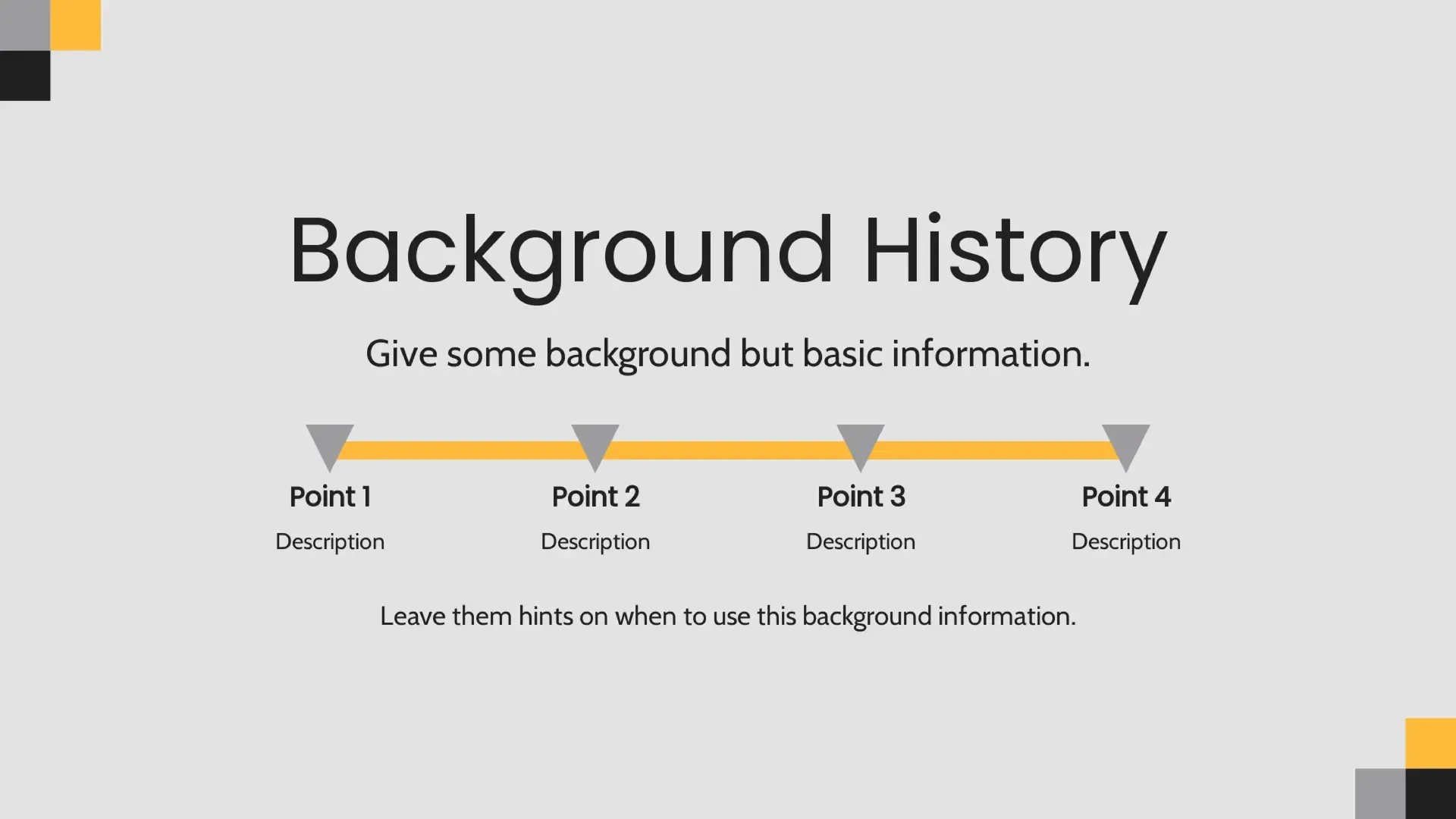
3. Problem Statement or Objectives:
Clearly state the problem or the main objectives of the case study. Define the issues or challenges that the study aims to address.
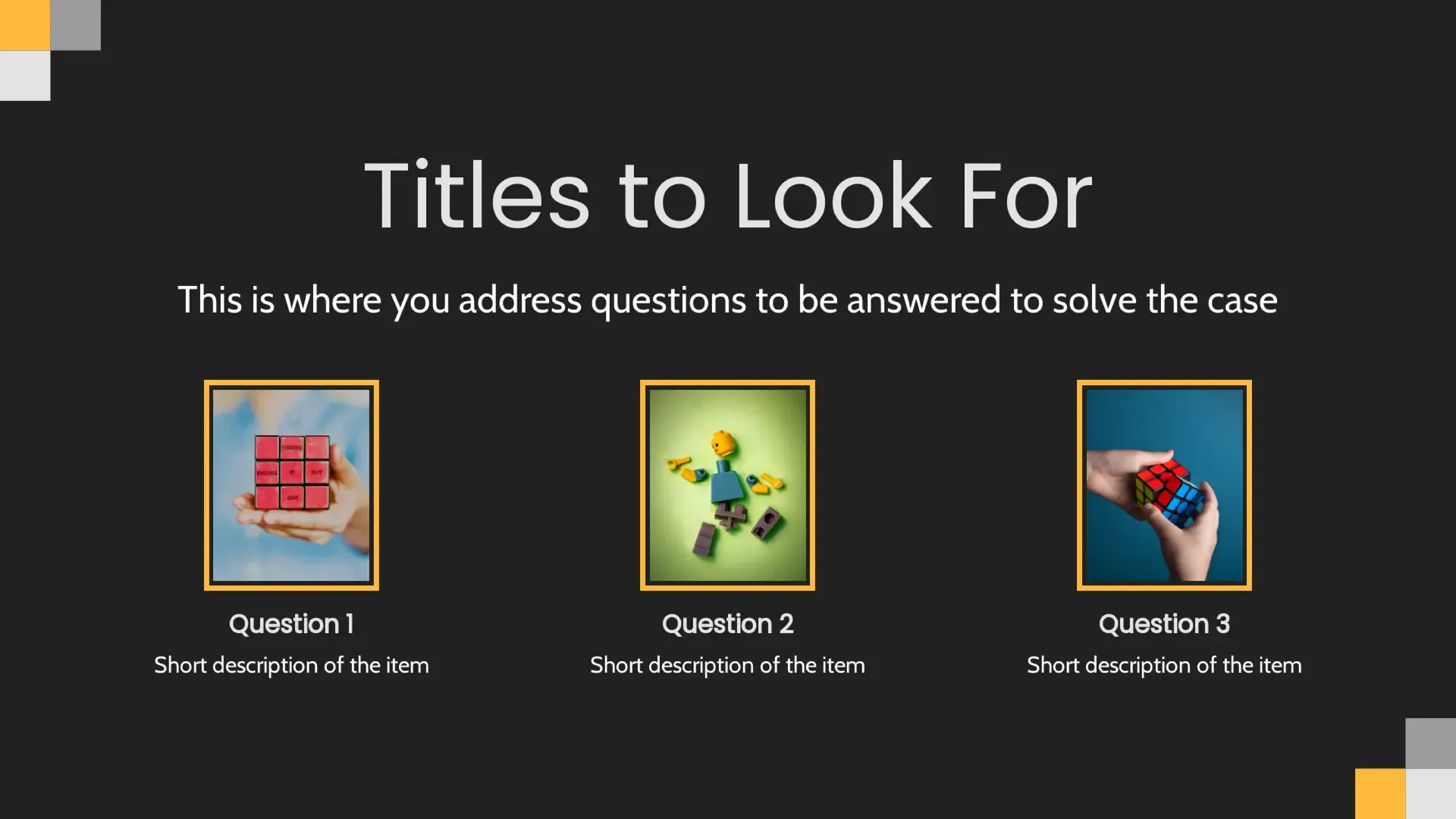
4. Analysis:
Dive into the analysis of the case. This section often comprises multiple sub-sections, each exploring different aspects such as market conditions, internal factors, external influences, etc.
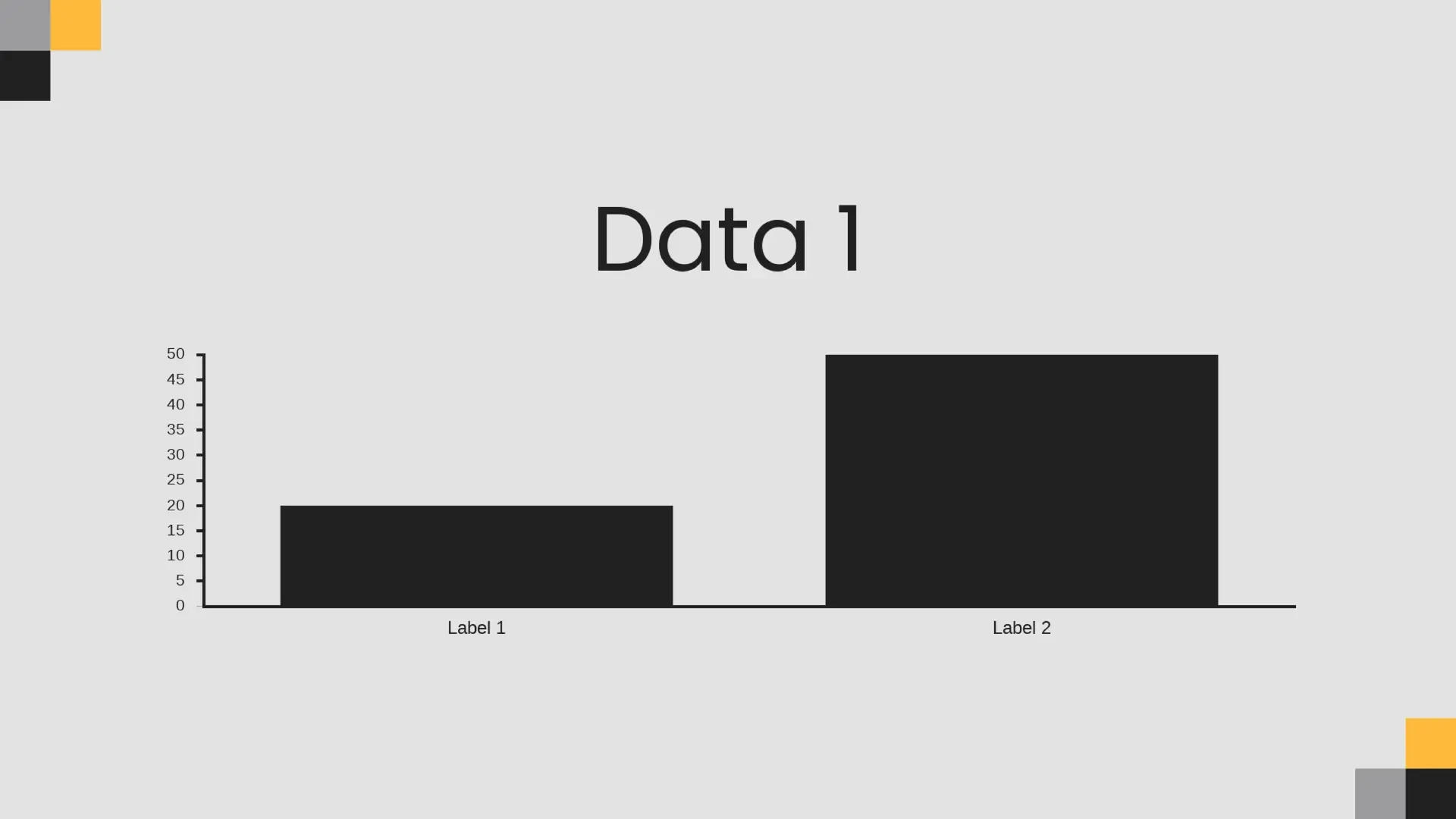
5. Solution or Action:
Propose solutions or actions to address the identified problems. Detail the steps taken or recommended strategies based on the analysis.
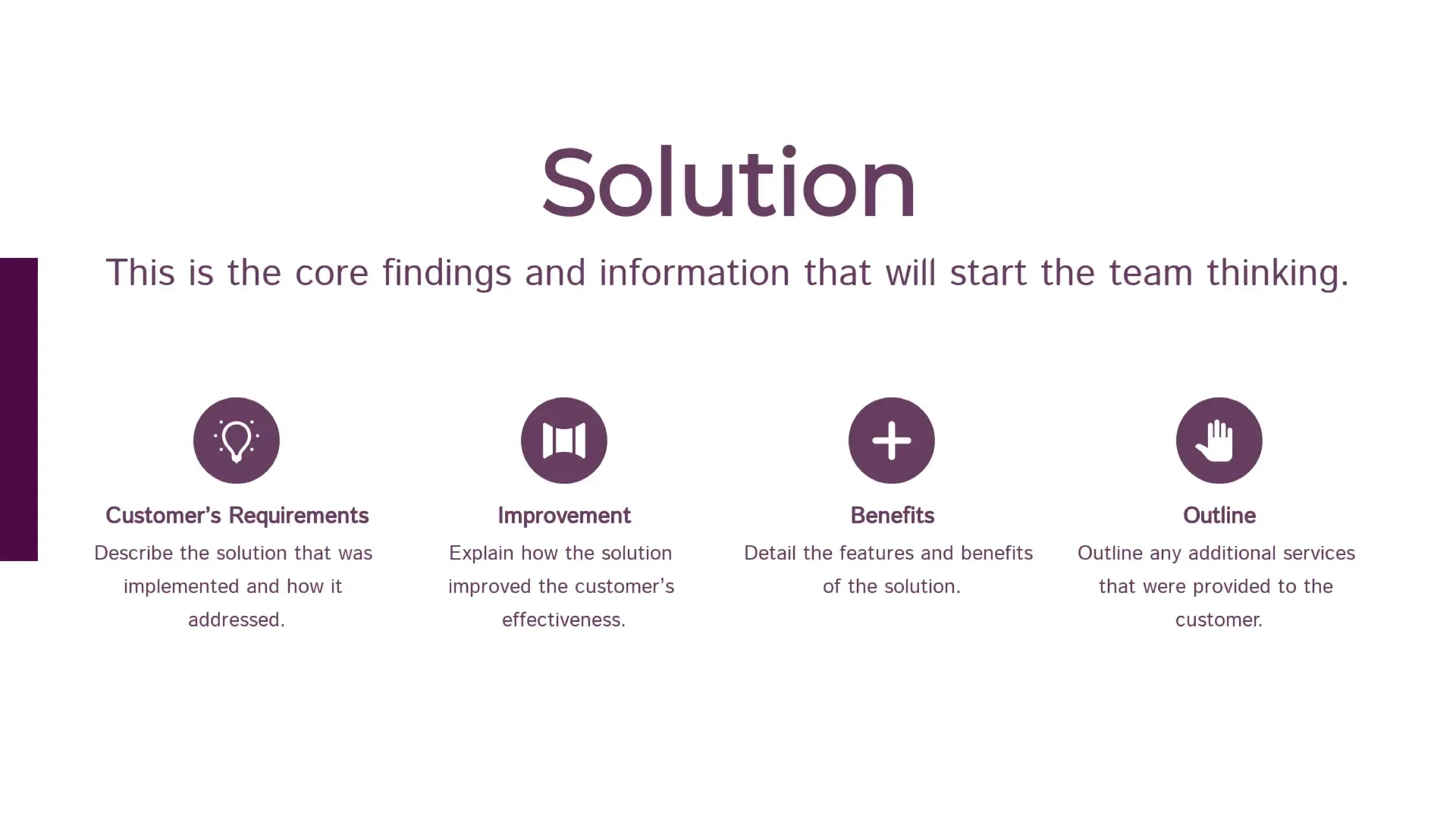
6. Results:
Present the outcomes of the solutions or actions taken. Include any measurable results, impacts, or changes observed.
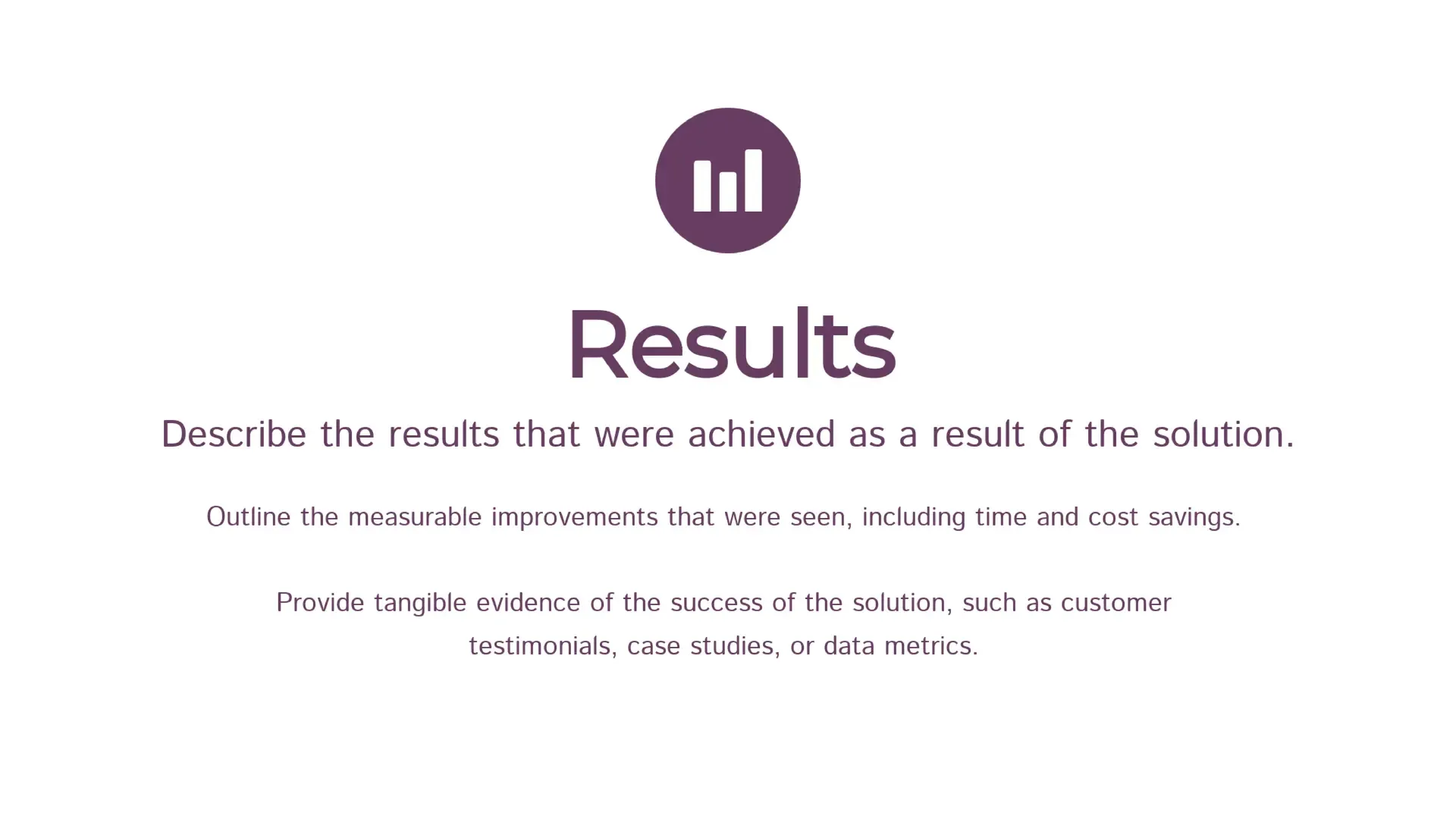
7. Conclusion:
Summarize the key points, outcomes, and lessons learned. Revisit the problem statement and emphasize the significance of the study, highlighting how the research design shaped the results.

Types of Case Studies
Case study examples, 1. marketing case study template.

The Marketing Case Study Template is tailored for marketers, highlighting successful marketing strategies . Uncover the methods employed, target audience engagement, and measurable outcomes.
Ideal for marketing professionals seeking insights into effective campaign executions. With Decktopus AI , spending your precious time perpetually recreating your product's presentation has become an ancient practice.
Along with our collection of case-study templates, with our one-click platform, you can easily create beautiful presentations for yourself or your clients.
Also check out: creative marketing case study template .
2. Sales Case Study Template

The Sales Case Study Template is designed for salespeople to present and discuss case studies in sales meetings. With its professional look and engaging layout, your clients will be impressed with the level of detail you put into your analysis.
This professionally designed template is easy to use and easy to customize, making it the perfect way to show off your small business expertise.
So whether you're looking to wow potential clients or just need a little more confidence in your sales meetings, our client case study template will help you make an impact.
Also check-out: case study template for sales teams .
3. Design Case Study Example: UI Case Study Template

The UI Case Study Template is specifically designed for UI designers, making it easy to discuss your design process and findings. Present your design case studies like a pro with our target-spesific case study templates. With our design case study template , you'll be able to showcase your work in a clear, professional manner.
Looking to create a stunning case study presentation for your next client meeting? Look no further than our case study templates! Our professional and easy-to-use templates are perfect for designers of all experience levels, and will help you showcase your work in a clear and concise way.
Also check out: Art Case Study Template .
Explore More Case Study Templates

Discover a vast collection of case study templates from various fields, including marketing, sales, and design, in our dedicated Case Study Examples Blog. Gain insights into diverse business scenarios and find inspiration for your own projects.
Case Study Presentation Creation with Decktopus AI
Streamlining the creation of engaging visual case studies has never been easier than with Decktopus AI . This innovative platform offers a seamless experiencensimply write your input, and Decktopus takes care of the rest, ensuring that your templates not only boast a polished visual appeal but also integrate relevant and impactful content effortlessly.
Discover how easy it is to create engaging case study templates using Decktopus AI . Our platform ensures your templates look great and contain relevant content. With the help of our AI assistant, you not only get support during presentations but also receive tips, facilitate Q&A, and increase overall engagement.
Explore the unique storytelling format that Decktopus offers, making your case studies more relatable. For a step-by-guide on how to easily create a visually stunning case study with Decktopus, see our case study examples blog.

This approach allows you to present information in a narrative style, connecting better with your audience. Find practical tips for smoother case study presentations, from effective storytelling to engaging your audience. Improve your presentation experience with Decktopus AI , where simplicity meets interactivity and storytelling for effective communication.
It features, practical design, mobilizing easy principles of marketing ecosystem platform design. Making it by far the easiest thing to use in your daily practice of mobilizing marketing ecosystems through platform strategies.
Frequently Asked Questions
1) what is a marketing case study.
A marketing case study is a concise analysis of a business's marketing strategy, showcasing its objectives, challenges, tactics, and outcomes. It offers practical insights into real-world marketing applications, serving as a valuable learning tool for understanding successful practices and lessons learned in achieving specific marketing goals.
2) What is a case study?
A case study, or case report, is a concise examination of a specific subject, often real-world situations or problems, providing detailed insights and analysis for learning or decision-making purposes.
3) How should you write a case study?
To create an impactful case study, define objectives, choose a relevant case, gather key information, and use Decktopus for a polished presentation. Employ data analysis, construct a clear narrative, and offer actionable recommendations.
Validate findings and consider broader implications. Decktopus streamlines this process, providing a user-friendly platform for creating compelling case study presentations effortlessly.
Latest Articles
%20(1).avif)
November 13, 2024
Enhance Your Content with AI Writing Detector and AI Content Detector: ChatGPT and Copyleaks AI Detector Tools
Improve content authenticity with AI detector tools like ChatGPT and Copyleaks AI Discover AI writing, its impact and limitations Get to know GPTZero!
%20(1).jpg)
October 21, 2024
Top 10 Online Slideshow Creators: Make Slideshow Videos
Would you like to make a slideshow video? If you don't know where to start, here are the top 10 slideshow creators. You can make a slideshow with Decktopus, and more!

October 15, 2024
Unlock Market Insights: What Is Segmentation Analysis?
Discover how segmentation analysis uncovers customer insights for targeted market strategies Master your segments now!

Don't waste your time designing your presentations by yourself!
Type your content and let our platform design your presentations automatically. No more wasting time for your presentations. Use hundreds of presentation templates to impress your audience. This is the only tool you need to prepare presentations. Try our Presentation Builder today >>
Don’t waste your time by trying to make a website for all your content
Place your content links and let our platform design your bio link automatically. No more wasting time for your social content distribution. Use hundreds of presentation biolink to impress your audience. This is the only tool you need to prepare good-looking bio links. Try our Bio Link Builder today >>
Do You Want To Create a Presentation?
Sign up for our newsletter to stay up-to-date on the latest news and tips from Decktopus.
Let’s create a form here to get visitors’ email addresses.
Ready to dive in? Start your free trial today.

What is a Case Study: A Complete Guide of Case Study Basics

What is a case study? A case study is an in-depth analysis of a real-life situation or project in business. Case studies are not just theoretical exercises; they are practical tools that can empower marketers and entrepreneurs. They showcase successes, offer insights into practical strategies, and help attract and convert potential clients.
What is a Case Study
- Definition: In-depth analysis of a real-life business situation or project, providing insights and showcasing successes.
- Purpose of a Case Study: Demonstrate effective strategies and attract potential clients by highlighting real-world applications and results.
- Components: Background, executive summary, challenges, solutions, conclusion, and call-to-action.
Let’s delve into the transformative potential of case studies in different business contexts. With the right case study templates, we can decode the perplexing concept of case studies and understand their importance, from their definition to their advantages. This understanding can inspire new strategies and approaches in your business.
Table of Contents
Specific case studies for different industries, why are case studies important.
- Benefits and Limitations of Case Studies

Case Study vs Use Case
Case study vs. white paper.
- Case Study vs Survey
Case Study vs. Research Study
- Case Study vs Report
What Does a Case Study Look Like
What is a case study method, is case study qualitative or quantitative, types of case studies.
Let’s explore how to define a case study and what it means for business success.
A case study is more than just a report; it’s a window into real-world business challenges and triumphs. As per the case study definition, it’s like a roadmap, guiding marketing associates, small business owners, and company leaders through identifying challenges and showing strategic solutions for success.
Through information gathering, client interviews, and deep analysis, case studies shed light on the past hurdles and the strategies that conquered them. These are not just for showcasing achievements; these are invaluable tools for training new team members and impressing potential clients. But to make them truly impactful, they need structure and finesse.
Here’s a staggering fact that underscores the importance of case studies. About 29% of prospects rely on case studies to make informed purchasing decisions. This highlights the significant role case studies play in shaping business outcomes.
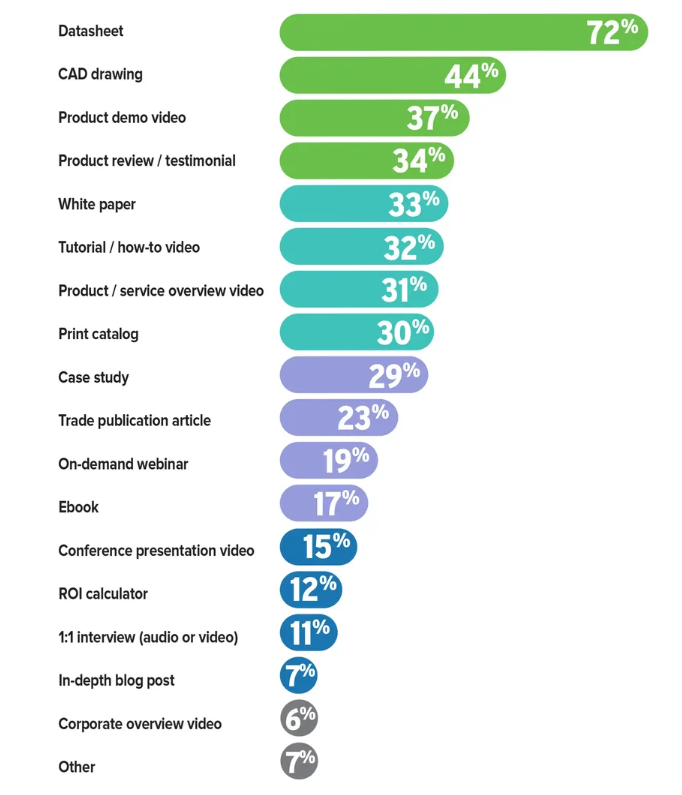
We understand your business goals and solutions are particular, and you need a case study design that suits your purpose. Let’s explore different case studies and how to align them with your business.
What is a Case Study in Accounting
A brilliant case study in accounting illuminates the practical application of accounting principles in a real-world scenario. It should be informative and engaging, demonstrating the impact of sound accounting practices.
If you need to create an accounting case study, always focus on clean, clutter-free design formats that leave enough room to discuss real-life scenarios, like the following case study template.

Get This Template and More
Curious about what to include in a case study for accounting firms?
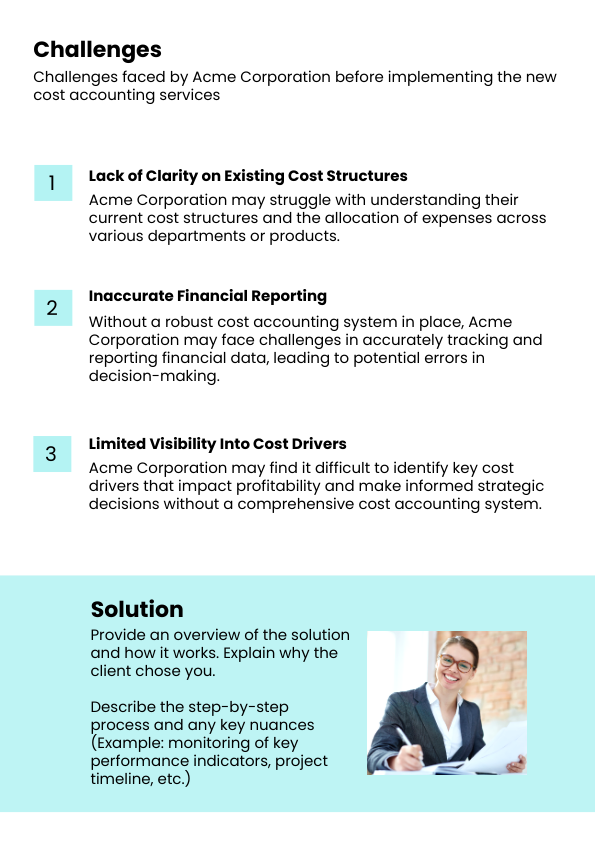
As shown in the example of the case study in accounting, there are relatable accounting issues, such as improving profitability, optimizing cash flow, or navigating a new tax regulation. Stay ahead by showcasing the specific accounting methods or strategies to address the client’s challenge. You can demonstrate your expertise by highlighting implemented accounting principles to achieve a positive outcome in your case study.
What are Management Consulting Case Studies
A consulting case study puts you in the shoes of a consultant tasked with analyzing the situation and recommending solutions. It’s a chance to showcase your problem-solving skills and strategic thinking under pressure.
Here’s a consulting case study example template.

Use a structured approach to describe the issue, showcasing your adeptness in critical thinking and solution prioritization in the case study for consulting. Additionally, utilize case study templates of various consulting disciplines such as management, strategy, and leadership consulting. These templates display your proficiency in breaking down the problem systematically, addressing a tangible challenge encountered by a particular company or industry.
Here’s an example of an HR consulting case study that’s easily customizable.
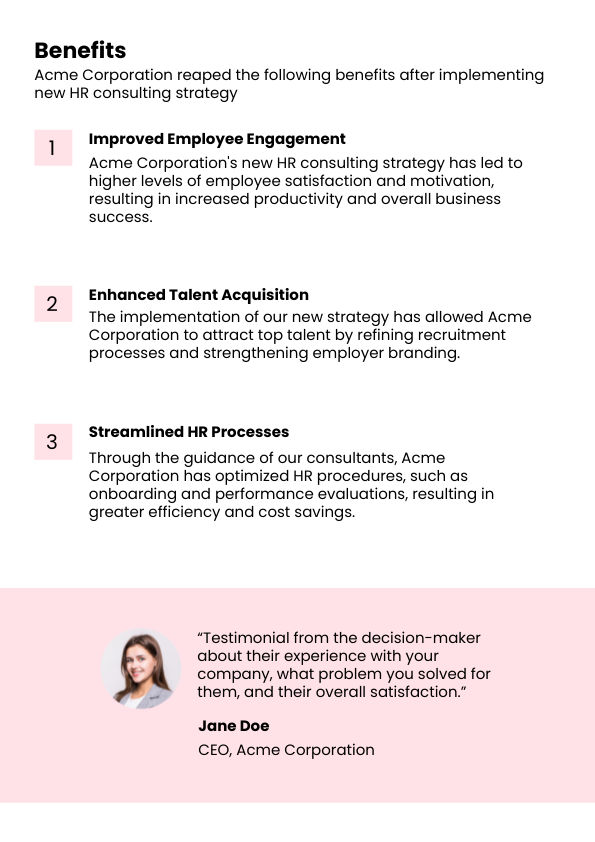
What is a Design Case Study
Think of a design case study as a visual narrative. It tells the story of a design project, from the initial challenge to the final, successful solution. Moreover, it showcases your design process, decision-making, and work’s impact on the client’s goals.
Therefore, your design case study should align with the services you can offer for your client’s problem. DocHipo provides case studies on UI design, motion design, illustration design, brand identity and advertising design, and many other design-related templates.
Check out the web design case study template that starts with a clear and relatable design problem.

After showcasing relevant user research data and insights to demonstrate a data-driven solution, you must add a strong call to action and brief information about your company to convert your leads into customers.
What is a Case Study for IT Company
Case studies for IT companies are success stories that showcase expertise in solving B2B real-world problems through technology. They are a way to demonstrate your capabilities, build trust with potential clients, and position yourself as a trusted advisor.
But what makes a great IT case study?
Use relevant data and metrics to depict the client’s initial situation. This could include IT costs, system downtime, or user productivity levels. You can create case studies for mobile app development, web development, and cyber security services to set your company apart in IT and management solutions.
Let’s explore the example of a case study for project management tailored to the needs of project managers and marketing executives.

This customizable template allows you to display the IT solutions you implemented and explain how you addressed the client’s needs.
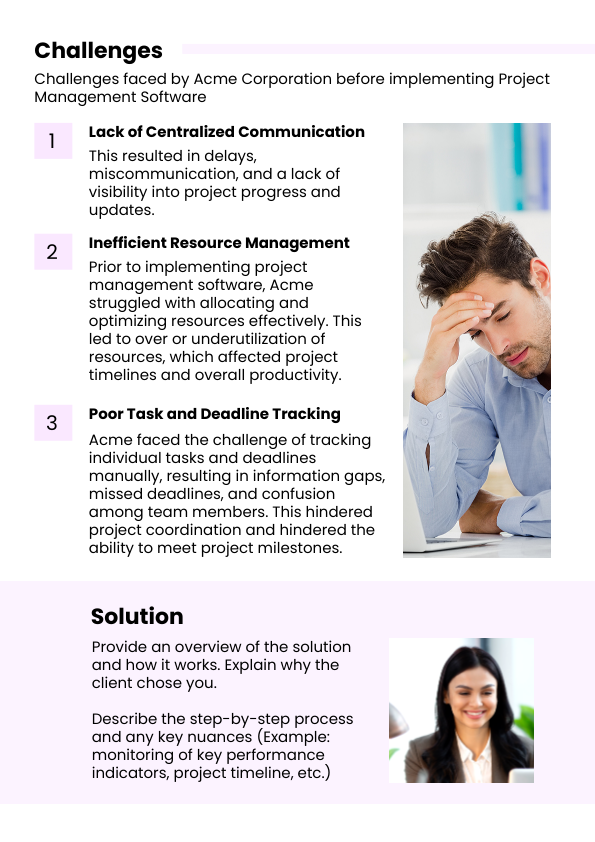
What is a Case Study in Marketing
Curious about marketing case studies? These powerful tools reveal how your offerings drive success for clients. Whether external client victories or internal wins, a marketing case study paints a vivid picture of achievement.
From company backstory to concrete results, it covers all bases: background, challenges, solutions, actions, and outcomes. Plus, it’s not just about words—incorporating visuals and client testimonials boosts credibility.
Check out the marketing case study example templates that pave the path to success in your business endeavors.

This marketing case study template immediately grabs your attention with its clean and modern design, ensuring every detail is easy to follow and understand.
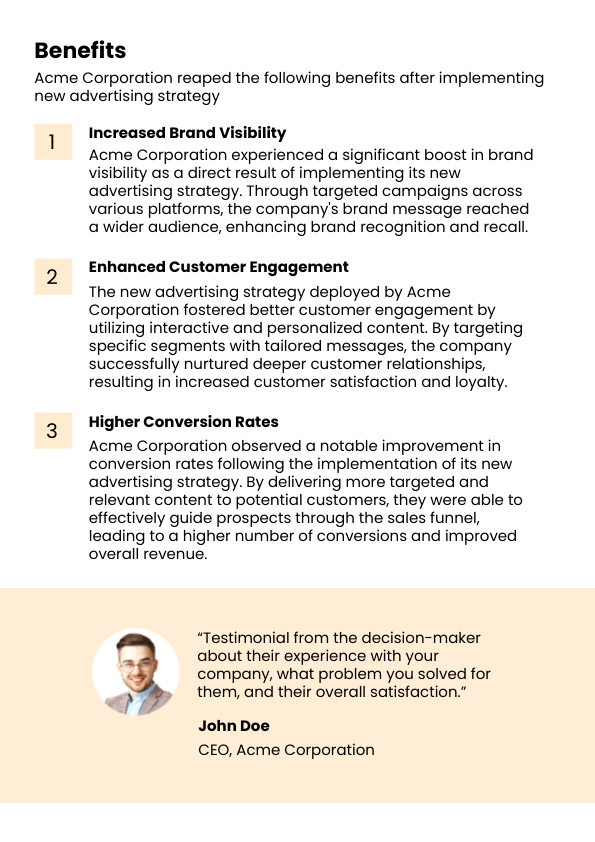
Writing a compelling marketing case study starts with the customer. The above advertising case study template tells the story of a real client facing a relatable challenge. As we said before, a marketing case study is your sweet spot for engaging your leads who want to overcome the same challenging situations. Let it lead the way for your inventive solutions, ensuring credibility and a top spot in the B2B market.
Turn heads and win hearts with DocHipo’s marketing case study templates . From digital marketing to mobile marketing, search engine optimization, email marketing, and beyond, these templates help you tell your success stories in a way that connects with real people.
What are Case Studies in Sofware
Imagine a compelling story that brings your software to life. A software case study delves into a real-world scenario where your software tackled a specific challenge for a client. It demonstrates your software’s problem-solving capabilities and the positive outcomes it delivered.
DocHipo software case studies are useful for niche-based services, from HR to AI assistant software.
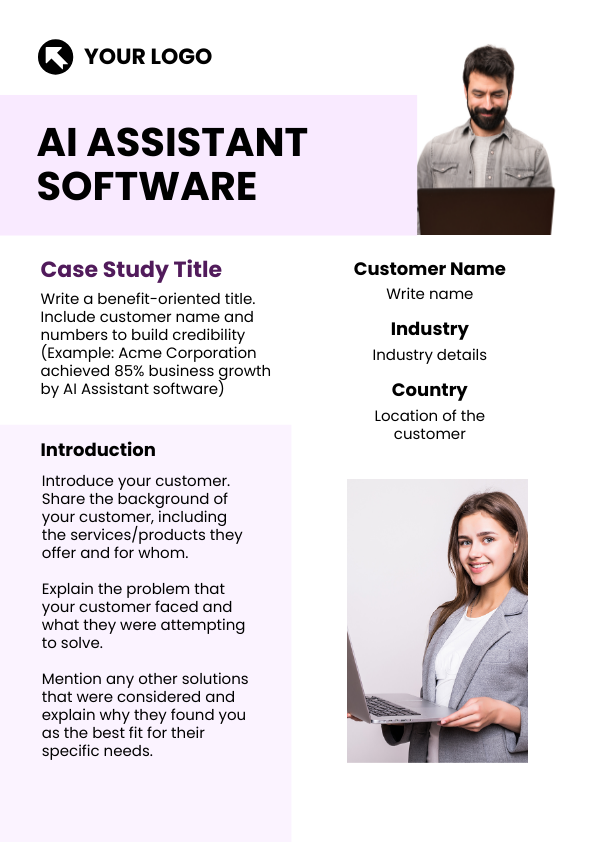
Introduce the client’s struggles and showcase how your software provided the solution. Demonstrate the positive impact your software had on the client’s business goals. This could be increased efficiency, cost savings, or improved user engagement.
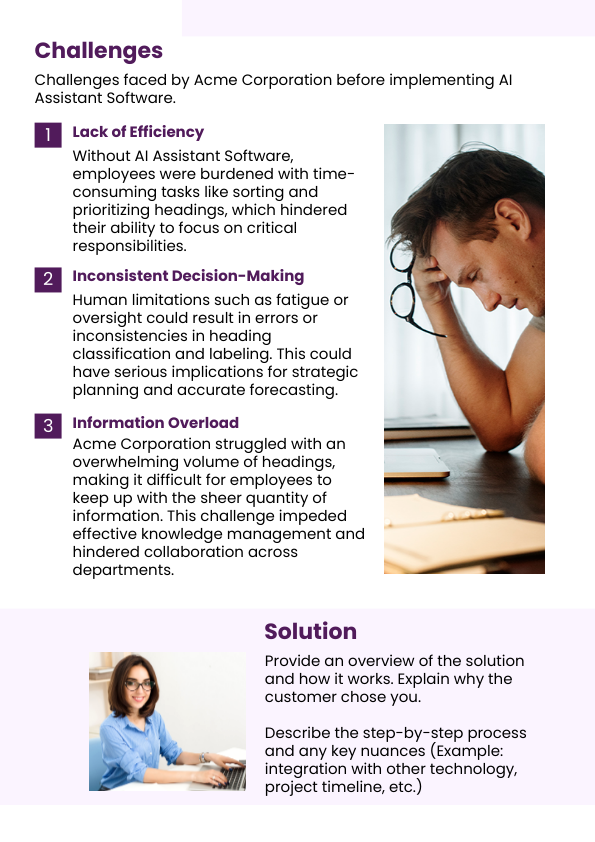
What are Case Studies in Business
A business case study is like a detailed story about a company. It shows how they solved a problem, succeeded, or faced challenges. Companies use these stories to share how well their ideas and strategies worked.
Here is a business case study example from Trello .
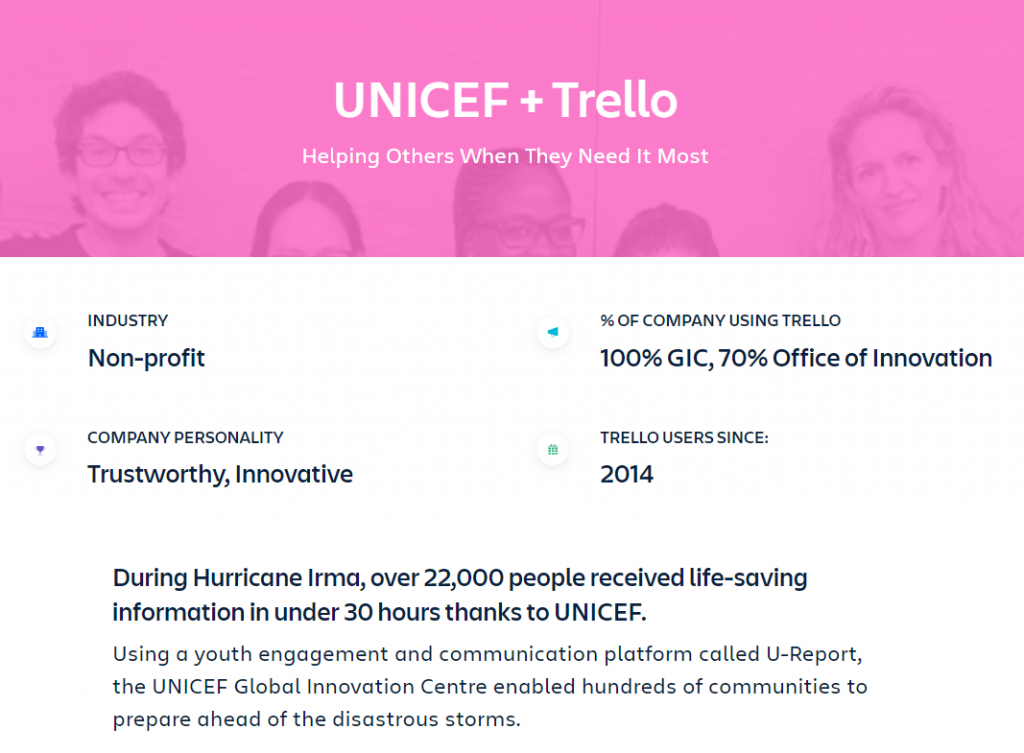
What is the purpose of a case study? Case studies thoroughly evaluate specific situations. They reveal which strategies worked, which didn’t, and what could be improved. This insight is invaluable for future planning.
Furthermore, case studies help identify potential solutions to problems. Examining similar past situations allows you to discover effective strategies and avoid common pitfalls.
Finally, use case studies to target your audience and showcase your expertise. Publishing successful case studies demonstrates your ability to solve problems, boost your credibility, and attract more business. Essentially, case studies serve as the original form of social proof, highlighting your problem-solving skills and success stories.
Benefits and Limitations of Case Studies
Before creating this SEO-centric lead magnet, you should consider the advantages and disadvantages of case studies.
We’ve listed the difference between a use case and a case study.
Often, marketers get misled by the similarities between a case study and a white paper. Though both are time-consuming and heavily research-oriented, everything about the two types of content is distinguishable, from the content format to the goals.
Case Study vs Survey
Though case studies and surveys can both use quantitative and qualitative methods, often known as mixed methodology, some distinguishable factors draw a prominent line between the two types of marketing and research content.
The research study aims to address a specific issue promptly. In contrast, case studies are conducted over a longer period. They focus on observing and analyzing an ongoing phenomenon. Here are the key differences that will help you better understand the format and purpose of a case study and research paper.
Case Study vs Report
Even though case studies and case reports have been used interchangeably, the format of a case study is distinctively different from that of a case report.
A basic, insightful case study has six aspects to focus on in its design; take a look at the case study template.

- Background: Provide essential context about the client or situation.
- Executive Summary: Capture attention with a brief introduction to the subject, the company’s products, services, challenges, and the reason for partnering with you.
- Challenges: Analyze and explain the specifics of the challenges faced by the client.
- Proposed Solutions: Present and justify the recommended solutions clearly.
- Conclusion: Summarize key takeaways, highlighting the client’s success with data and quotes.
- Call-to-Action: Include contact channels and a strong CTA like “Call Us” or “Visit Us.”
The methods used in case study writing are varied and adaptable, tailored to the specific needs of each case. Here are some common case study methods:
1. Interviews
Interviews involve engaging with individuals directly related to the case to gather first-hand information and insights.
Key points:
- One-on-one or group settings
- In-depth and personal perspectives
- Allows follow-up questions for clarity
When is this method useful:
Ideal for cases requiring detailed personal experiences, such as understanding customer satisfaction or employee feedback.
2. Observation
Observation entails directly watching the subject or situation to collect data on behaviors and interactions.
- Real-time data collection
- Provides contextual details
- Minimally intrusive if done discretely
Best for studies needing direct insights into processes, like workflow efficiency or consumer behavior.
3. Document Analysis
Document analysis examines existing documents and records relevant to the case.
Key Points:
- Uses existing written materials
- Provides historical context
- Can validate other data sources
Suitable for cases involving historical research or policy analysis.
4. Surveys and Questionnaires
Surveys and questionnaires are used to collect quantitative data from relevant stakeholders.
- Structured and standardized method
- Efficient for large sample sizes
- Quantifiable data for statistical analysis
Ideal for cases needing broad quantitative insights, like market research or employee satisfaction studies.
5. Participant Observation
Participant observation combines direct observation with active involvement in the activities related to the case.
- Insider’s perspective
- Rich, detailed data
- Balances observation with participation
Useful for ethnographic studies or understanding cultural practices within an organization.
6. Triangulation
Triangulation involves using multiple methods to cross-verify and validate findings.
- Enhances reliability
- Cross-verifies data
- Integrates diverse perspectives
Ideal for comprehensive studies requiring robust validation, like multi-faceted business issues.
7. Ethnography
Ethnography immerses the researcher in the subject’s environment over an extended period to understand cultural contexts.
- Long-term immersion
- Focus on social dynamics
- In-depth cultural insights
Best for understanding complex social interactions and cultural phenomena.
A case study can actually be both. Ideally, it should blend objective measurements with subjective insights to give a full picture of what’s happening and why. The right mix of qualitative and quantitative data depends on the specific field and situation, but both types are incredibly valuable.
Think of it this way: qualitative data adds depth and context, while quantitative data provides hard facts and figures. Together, they offer a more detailed and nuanced understanding, moving beyond simple averages and generalizations.
There are six types of case study formats: Descriptive, Explanatory, Exploratory, Collective, Intrinsic, and Instrumental.
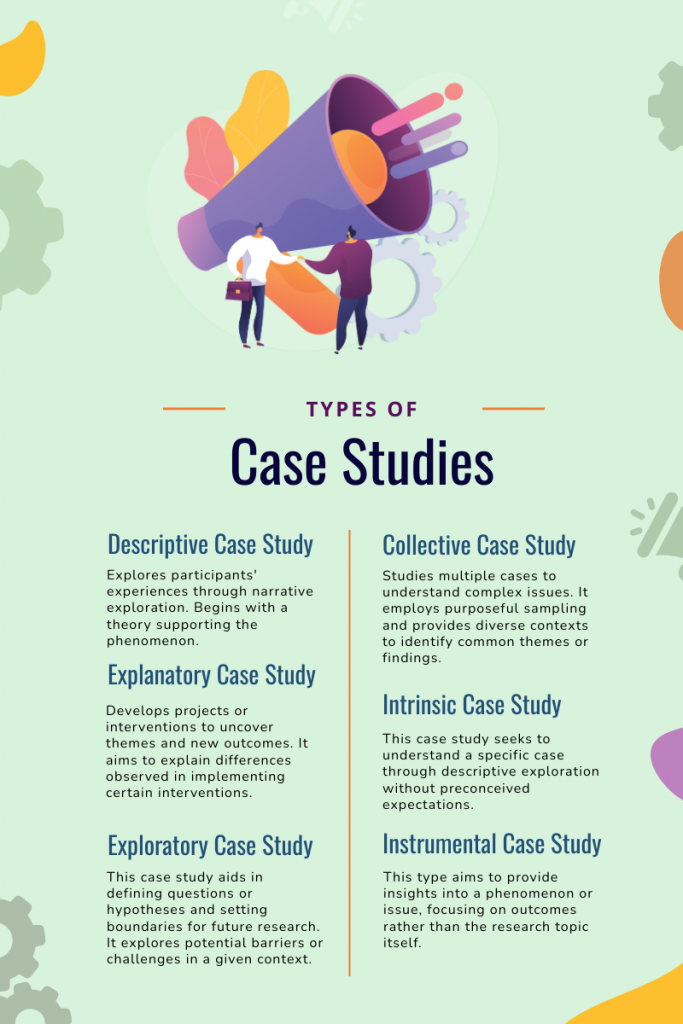
Knowing “What is a case study” should be the first step in creating a case study. Sometimes, marketers get stuck on how to make a case study easily. Try DocHipo case study templates with customizable designs in accounting, consulting, design, technical or IT services, marketing, and software. Sign up for free and save time with suitable pre-designed industry-specific challenges and benefits that align with your business solutions.
What are the limitations of a case study?
There are two main disadvantages: limited generalizability and applicability to broader contexts and the potential for researcher bias due to subjective data interpretation.
When should you do a case study?
A case study is ideal when you want to gain in-depth insights into a specific real-life situation or phenomenon. Also, you can use case studies to create a strong authority for your brand presence.
What is the difference between a case study and an essay?
A case study focuses on a specific real-life situation or problem and its solutions, while an essay is more general and can cover a wide range of topics. Also, the format and length of these two content are very different.
What is the difference between a case study and action research?
A case study is an in-depth analysis of a specific instance, while action research focuses on making specific changes to address a problem and involves reflection and inquiry.
How do you describe a case study?
A case study focuses on a real-life situation or problem. It provides a detailed analysis of the issue and discusses the solutions and their outcomes.
What are the most important parts of a case study?
A case study has six important parts: background, executive summary, challenges, solutions, conclusion, and CTA for conversion.

Turn your ideas into beautiful design
No prior design skill required

Talk to Sales
Wherever you are on your Dochipo journey, you can always get in touch.

Talk to Support

- Become a Partner
Latest Insights

3 Ways Enterprise SEOs Win Leadership Buy-In
Latest conversations.

Beyond Billboards: Debunking 5 OOH Myths
- Let's talk ▸
What Is a Case Study?
March 11, 2024 |, contributors.

Case studies give marketers a deep dive into a specific problem, process, or achievement within a company. They offer detailed insights into real-life business challenges and triumphs. Case studies provide a narrative that's informative and engaging, allowing readers to glean practical knowledge from real-world scenarios.
Case studies stand out for their ability to present complex data in a digestible format. They turn abstract numbers and statistics into relatable stories, making them an invaluable resource in the arsenal of any marketer. By showcasing specific examples of strategies that worked (or didn’t), case studies provide a unique learning opportunity that can be applied to similar situations in different organizations.
Benefits and Limitations of Case Studies
The power of detailed insight.
One of the most significant benefits of case studies is their capacity to provide detailed insights. Unlike broader market research, case studies delve into the specifics of a single situation, offering an in-depth understanding of the dynamics at play. This level of detail can be incredibly useful for businesses looking to understand the nuances of a particular strategy or problem. It allows for a more nuanced approach to problem-solving, as the specificity of a case study often highlights unique variables and outcomes that broader analyses may overlook.
Real-World Application
Case studies are grounded in real-world scenarios, making their lessons and findings directly applicable to similar situations in other organizations. By examining how a particular strategy or decision played out in a real context, businesses can better anticipate potential outcomes in their own situations.
Limitations: Generalizability and Bias
However, the very strength of case studies – their detailed focus on a single instance – is also their limitation. The findings of a case study might not apply to all situations. Since case studies often focus on unique cases, there’s a risk of drawing conclusions that don’t apply broadly.
Another limitation is the potential for bias. Since case studies are often retrospective and rely on the interpretation of events, there’s a risk of subjective bias in both the collection and interpretation of data. This can skew the insights and lessons derived from the study.
Despite these limitations, case studies are a powerful tool in the marketer’s toolkit, offering a unique blend of storytelling and empirical investigation.
Types of Case Studies
Explanatory case studies.
Explanatory case studies are often used in fields like social sciences to explain how or why certain events occurred. In a business context, explanatory case studies can be instrumental in unraveling the intricacies of business processes or market dynamics. They typically involve a detailed analysis of a situation or series of events to understand the underlying causes and effects. An explanatory case study's strength is its ability to provide clear, logical insights into complex scenarios.
Exploratory Case Studies
Exploratory case studies are typically conducted before a more in-depth investigation. Their primary purpose is to identify the key variables and potential relationships in a situation, setting the stage for more detailed analysis later. In marketing, exploratory case studies can help identify the factors contributing to a product's success or failure in the market. They are particularly useful in the early stages of research, where the goal is to gather as much information as possible to formulate more precise questions for further study.
Collective Case Studies
Collective case studies involve studying a group of cases simultaneously or sequentially. This approach is beneficial when the objective is to understand a phenomenon, population, or general condition more comprehensively. By examining multiple cases, marketers and business leaders can compare and contrast different scenarios, leading to a more robust and well-rounded understanding of the subject. Collective case studies are particularly useful for observing variations across different contexts, offering insights that might be overlooked when focusing on a single case.
Each type of case study serves a unique purpose and offers different insights, making them versatile tools for understanding complex business scenarios.
Writing and Analysis Tips
Structuring and formatting a case study.
When crafting a case study, be mindful of structure and format. A well-structured case study ensures clarity and enhances the reader's engagement and comprehension. Typically, a case study should begin with an introduction that sets the context and outlines the problem or situation being addressed. This is followed by a detailed presentation of the facts, including background information and a description of the events or processes involved.
The next section should involve an analysis of the case. This is where the data is interpreted and insights are drawn. It's crucial to link the theoretical framework to the practical aspects of the case, demonstrating how specific concepts apply to real-world scenarios. Finally, conclude with a section that synthesizes the findings, offering conclusions and if applicable, recommendations. This closing part should summarize the key insights and highlight the implications for practice and further research.
Developing Theories and Analyzing Results
Developing theories in case studies involves identifying patterns and relationships within the data. The goal is to move beyond the description to interpret the significance of what has been observed. This process requires critical thinking and the ability to link empirical evidence to broader concepts and theories.
Analyzing results in a case study involves scrutinizing the data to understand the 'why' and 'how' of the case. It's about digging deeper into the findings to unearth underlying principles or truths. This analysis should be rigorous and creative, combining empirical evidence with insightful interpretation.
Ensuring Validity and Reliability
To ensure the validity and reliability of a case study, use robust and transparent methods in data collection and analysis. Validity refers to the accuracy and truthfulness of the findings, while reliability pertains to the consistency of the results over time. Triangulation of data sources, where information is corroborated from multiple sources or methods, can enhance validity and reliability.
Furthermore, being transparent about the limitations of the case study, such as potential biases or constraints, helps maintain the integrity of the research. Providing a clear and detailed description of the methodology also allows others to assess the credibility of the findings.
These tips, when applied, can enhance the quality and impact of a case study, making it a powerful tool in business and marketing research.
Case Study Examples
Here are a few links to case studies done by 97th Floor:
SOLD.com : An agent-centric approach fuels SOLD.com's 322% ROI increase amidst housing market Challenges
Gigamon : The holistic SEO approach that won Gigamon their #1 keyword
Tuft & Needle : Connecting with Sleep-Deprived Parents to Increase Tuft and Needle’s Revenue by 57% YoY
These case studies provide tangible examples of how different strategies and innovations can be effectively applied in real-world business scenarios.
Case studies provide a unique blend of narrative storytelling and empirical investigation, making abstract concepts and strategies relatable and understandable. Whether explanatory, exploratory, or collective, each type of case study offers a different lens through which to view and solve business problems.
The insights from well-crafted case studies illuminate past successes and failures and pave the way for future innovations and strategies. By providing detailed analysis and real-world applications, case studies serve as a crucial tool for marketers and business leaders aiming to navigate the ever-evolving landscape of business challenges.
Ultimately, the value of a case study lies in its ability to inspire, inform, and guide. It's a resource that combines theoretical knowledge with practical experience, offering a comprehensive understanding. For any business looking to grow, adapt, and excel, leveraging the power of case studies is not just beneficial—it's essential.
A good case study is well-structured, detailed, and provides clear insights. It should present a real-world problem, outline the steps taken to address it and detail the results. Clarity, relevance, and the ability to engage the reader are key elements.
The length of a case study can vary depending on the complexity of the subject. Generally, it should be long enough to cover all relevant aspects of the case but concise enough to maintain the reader's interest. Typically, anywhere from 500 to 1500 words is standard.
While case studies provide valuable insights, they should not replace traditional market research. They are best used in conjunction with other forms of research to provide a comprehensive understanding of a market or problem.
Ensuring objectivity involves using a systematic approach in gathering and analyzing data, avoiding bias in selecting cases, and being transparent about the limitations of the study.
Yes, case studies are versatile and can be beneficial for businesses of all types and sizes. They are particularly useful for understanding specific situations in depth and can provide valuable insights regardless of the industry.
Small businesses can use case studies to learn from the experiences of others, understand market dynamics, and formulate strategies based on proven methods. They can also create their own case studies to showcase their successes and attract customers or investors.
In digital marketing, case studies can be used as powerful content pieces to demonstrate expertise, build trust, and provide value to the audience. They can be shared across various digital platforms, including social media, blogs, and email newsletters.
The frequency depends on the business's goals and resources. Regularly publishing case studies can keep the content fresh and relevant, but it's more important to focus on quality and relevance than frequency.
Absolutely. Case studies are excellent tools for employee training, as they provide real-life examples and scenarios for employees to learn from and discuss.
The effectiveness can be measured by its impact, such as increased website traffic, engagement rates, lead generation, and feedback from readers. Analyzing these metrics can provide insights into how well the case study resonates with the target audience.
Get 3 actionable growth tactics in your inbox, weekly.
Content related to what is a case study.


IMAGES
VIDEO